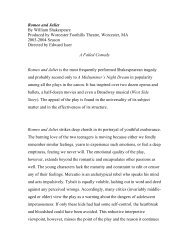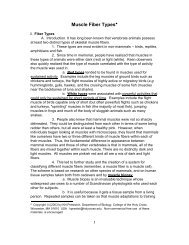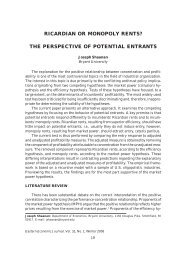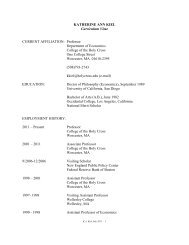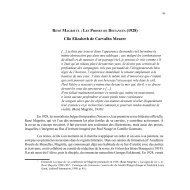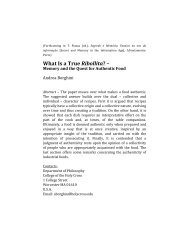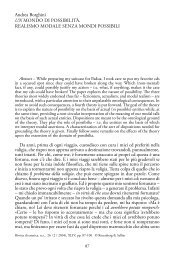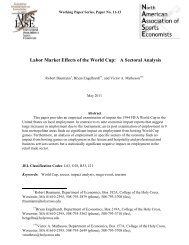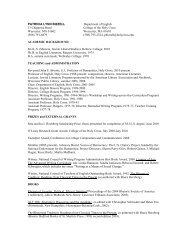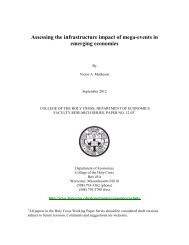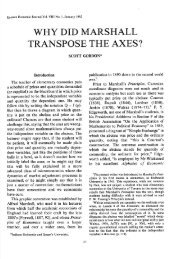29-2 Singh.pmd - College of the Holy Cross
29-2 Singh.pmd - College of the Holy Cross
29-2 Singh.pmd - College of the Holy Cross
You also want an ePaper? Increase the reach of your titles
YUMPU automatically turns print PDFs into web optimized ePapers that Google loves.
CAPITAL ACCOUNT LIBERALIZATION<br />
209<br />
Even if FDI is somewhat less volatile than o<strong>the</strong>r flows o<strong>the</strong>r important implications<br />
<strong>of</strong> FDI for a host country’s balance <strong>of</strong> payments need to be considered. These<br />
derive from <strong>the</strong> fact that an FDI investment creates foreign exchange liabilities not<br />
only now but also into <strong>the</strong> future. This characteristic leads to <strong>the</strong> danger that unfettered<br />
FDI may create a time pr<strong>of</strong>ile <strong>of</strong> foreign exchange outflows (in <strong>the</strong> form <strong>of</strong><br />
dividend payments or pr<strong>of</strong>its repatriation) and inflows (for example, fresh FDI) which<br />
may be time inconsistent. Experience shows that such incompatibility, even in <strong>the</strong><br />
short run may easily produce a liquidity crisis. The evidence from <strong>the</strong> Asian liquidity<br />
crisis suggests that it could degenerate into a solvency crisis with serious adverse<br />
consequences for economic development [Kregel, 1996; <strong>Singh</strong>, 2001].<br />
These considerations suggest that to avoid financial fragility <strong>the</strong> government<br />
would need to monitor and regulate <strong>the</strong> amount and timing <strong>of</strong> FDI. Since <strong>the</strong> nature<br />
<strong>of</strong> large FDI projects (whe<strong>the</strong>r or not for example <strong>the</strong>se would produce exportable<br />
products, or how large <strong>the</strong>ir imports would be) can also significantly affect <strong>the</strong> time<br />
pr<strong>of</strong>ile <strong>of</strong> aggregate foreign exchange inflows and outflows, both in <strong>the</strong> short and long<br />
term, <strong>the</strong> government may also need to regulate such investments. To <strong>the</strong> extent<br />
that <strong>the</strong> PMAI would not permit this kind <strong>of</strong> regulation <strong>of</strong> FDI, it would subject<br />
developing economies to much greater financial fragility.<br />
It could in principle be argued that even if <strong>the</strong> financial fragility point is conceded,<br />
a PMAI may still benefit developing countries by generating greater overall<br />
FDI, which could compensate for <strong>the</strong> increased financial fragility. The validity <strong>of</strong> this<br />
proposition, however, is doubtful. We saw earlier that FDI has risen significantly in<br />
<strong>the</strong> 1990s. This occurred without any MAI and was clearly a product <strong>of</strong> a number <strong>of</strong><br />
o<strong>the</strong>r factors. 18 Similarly, regulatory constraints on FDI and <strong>the</strong> total amount <strong>of</strong> FDI<br />
that a country is able to attract do not appear to be related. Malaysia [U.S., 1996]<br />
and China, [Braunstein and Epstein, 1999], for example, are large recipients <strong>of</strong> FDI<br />
despite having significant control and regulation over FDI projects.<br />
FDI AND REAL ECONOMY, TECHNOLOGY TRANSFER, SPILLOVERS,<br />
INVESTMENT AND SAVINGS<br />
Apart from FDI as a source <strong>of</strong> finance, two <strong>of</strong> <strong>the</strong> most important ways in which<br />
a developing country may benefit from such investments is (a) through transfer <strong>of</strong><br />
technology and (b) from spillovers. The latter refer to <strong>the</strong> effects <strong>of</strong> FDI on raising<br />
productivity in local firms. These firms may be helped by foreign investment in a<br />
variety <strong>of</strong> ways, including <strong>the</strong> demonstration effect <strong>of</strong> <strong>the</strong> new technology and <strong>the</strong><br />
enhancement <strong>of</strong> <strong>the</strong> quality <strong>of</strong> inputs which such investment may promote. On <strong>the</strong><br />
o<strong>the</strong>r hand <strong>the</strong>re may be few positive or even negative spillovers, if FDI forces local<br />
firms out <strong>of</strong> <strong>the</strong> market because <strong>of</strong> greater competition.<br />
Both issues <strong>of</strong> technology transfer and spillovers have been widely studied, resulting<br />
in a large and controversial literature. The main lesson it provides in relation<br />
to <strong>the</strong> question <strong>of</strong> technology transfer is that a country is more likely to benefit from<br />
multinational investment if FDI is integrated into its national development and technological<br />
plans [Dunning, 1994; Freeman, 1989; Milberg, 1999; South Centre, 2000].



